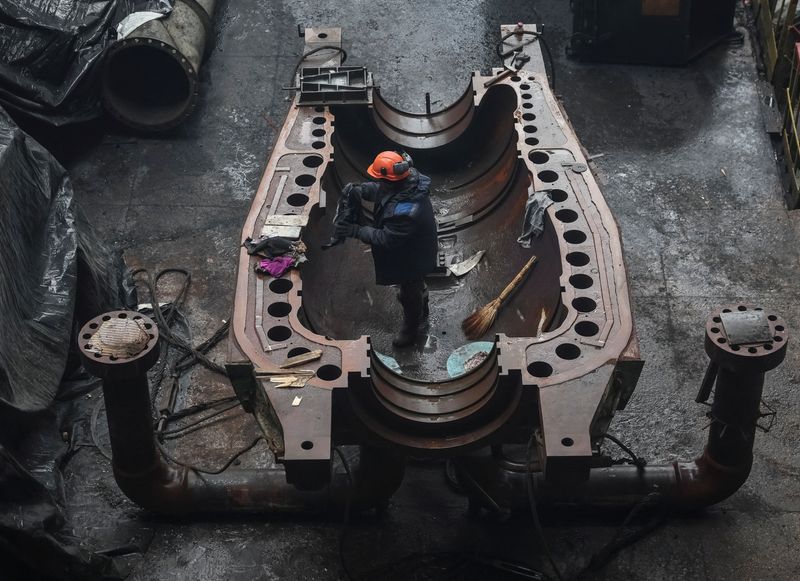
By Tom Balmforth
(Reuters) – When Russian missiles hurtle towards the Ukrainian power plant and employees scramble for the bomb shelter, a handful of workers stay above ground in a control room protected by sandbags to keep the system running manually.
The facility, the location of which energy officials asked Reuters not to identify for security reasons, has been pounded by missiles this year in an aerial assault on the grid that Russia renewed this month as the war’s third winter sets in.
“When there are attacks, we stay here even though we know there are missiles coming at us … To say we’re not afraid is not true because we are all living, normal people and we are afraid,” said Serhii, 52, a shift leader who has worked at the plant for over 30 years.
Outside the control hub is a vast machine room that has holes in its walls and extensive damage after missile strikes, the most recent of which were on Nov. 17 in this facility.
The smell of burning hung in the air during a recent Reuters visit, as water dripped from a damaged roof.
Missile parts lay on the floor, twisted metal sheets were stacked up to the side and broken pieces of equipment were strewn around. Workers in grubby overalls busied themselves with repairs and clambered over a damaged power unit.
Serhii, who declined to provide his surname, and his fellow workers see themselves as on the front line of a crucial battle in the 33-month-old war with Russia – to supply millions of people with power despite the attacks.
Russia, which denies targeting civilian infrastructure but views the Ukrainian power system as a legitimate target in its war, has inflicted major damage on energy facilities since it began a spate of attacks on the grid in spring.
The facility is one of five remaining thermal power plants owned by DTEK, Ukraine’s largest private power provider, which provided a quarter of the country’s electricity needs before Moscow’s February 2022 invasion.
As well as the location, DTEK asked Reuters not to disclose certain details about the plant, including the amount of electricity it currently produces, saying such information could help Russia conduct future strikes.
The facility, which typically provides electricity and heating to hundreds of thousands of people, has undergone major repairs throughout much of the year. The November attacks created more urgent repair work.
“We’ve been set back six months,” said Oleksandr, 52, a senior worker at the plant.
‘WINTER WON’T BE EASY’
Russia unleashed its second big attack on Ukraine’s energy infrastructure this month on Thursday, triggering deep power cuts across the country.
After the two waves of attacks, the outlook for Ukraine’s energy grid has worsened at a volatile moment in the war, with Russian troops advancing in the east and Donald Trump preparing to enter the White House on Jan. 20.
Ukraine repaired some of its energy infrastructure that was hammered in the spring and summer, putting it in what had looked like an unexpectedly strong position for the looming winter, industry sources said.
But now they say the damage inflicted on Nov. 17 and Nov. 28 has set them back significantly, raising the prospect of long blackouts and other outages in the depths of winter. Temperatures are already hovering around 0 Celsius (32 Fahrenheit).
One industry source said that, despite the setbacks, Ukraine would be able to handle the looming challenges.

The workers interviewed by Reuters at the plant said they would do their best.
“This is our front, some of the guys have a front in the east, our front is here. Our task is to ensure that our Ukraine has electricity, that it functions in full,” said Serhii.
This post is originally published on INVESTING.





